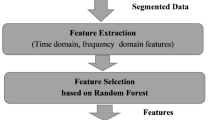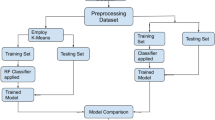Abstract
The traditional Zero Velocity Updating algorithm can be used to correct the accumulated errors of the device effectively. However, as the threshold value of the traditional Zero Velocity Updating algorithm is fixed, it is only suitable for a single motion mode. When indoor pedestrian motion includes multiple motion modes, the positioning accuracy will be greatly reduced. In this paper, we propose a half-voting random forest algorithm, an adaptive Zero Velocity Updating method for multi-motion mode using half-voting Random Forest. Half-voting Random Forest Algorithm means that in the decision tree voting process, the decision tree stops voting when the voting number reaches half of the voting volume. We determined the optimal thresholds of Zero Velocity Updating value for standing still, walking, running, going upstairs and downstairs for the indoor pedestrian. Then we recognize pedestrian motion modes by Random Forest with half-voting and weighted decision trees. Finally, we assign the optimal threshold based on the motion modes for Zero Velocity Updating. In order to verify the feasibility and effectiveness of the method proposed in this paper, field experiments were carried out with the inertial navigation module developed by our laboratory. The experimental results show that when indoor pedestrians perform multi-mode motion, the positioning error is 0.5 m.








Similar content being viewed by others
REFERENCES
Gu Zhidan, Li Qing, and Zhao Hui, Multi-stage filtering method for pedestrian autonomous navigation and positioning, J. Syst. Simul., 2018, vol. 30, pp. 4727–4731, 4737.
Zuo Desheng, Pedestrian Autonomous Navigation Positioning Algorithm Research, Harbin Institute of Technology, 2018.
Ming Ma, An adaptive zero velocity detection algorithm based on multi-sensor fusion for a pedestrain navigation system, Sensors, 2018, vol. 18, p. 3261.
Zhang, R., Yang, H., Hoflinger, F., and Reindl, L.M., Adaptive zero velocity update based on velocity classification for pedestrian tracking, IEEE Sens. J., 2017, vol. 17, pp. 2137–2145.
Park, S.K. and Suh, Y.S., A zero velocity detection algorithm using inertial sensors for pedestrian navigation systems, Sensors, 2010, vol. 10, pp. 9163–9178.
Ma, M., Song, Q., Li, Y.H., and Zhou, Z., A zero velocity intervals detection algorithm based on sensor fusion for indoor navigation systems, Proceeding of the International Conference on Electronics, Electrical Engineering and Information Science, Chengdu, 2017, pp. 15–17.
Ren, M., Pan, K., Liu, Y., Guo, H., Zhang, X., and Wang, P., A novel pedestrian navigation algorithm for a foot-mounted inertial-sensor-based system, Sensors, 2016, vol. 16, p. 139.
Mur-Artal, R., Montiel, J.M.M., and Tardós, J.D., ORB-SLAM2: An open-source SLAM system for monocular, stereo, and RGB-D cameras, IEEE Trans. Rob., 2016, vol. 33, no. 5, pp. 1255–1262.
Rantanen, J., Makela, M., and Ruotsalainen, L., Motion context adaptive fusion of inertial and visual pedestrian navigation, 2018 International Conference on Indoor Positioning and Indoor Navigation (IPIN), 2018.
Mengyun, L., Ruizhi, C., Deren, L., et al., Scene recognition for indoor localization using a multi-sensor fusion approach, Sensors, 2017, vol. 17, no. 12, p. 2847.
Nilsson, J.O., Skog, I.H., and Ndel, P., Foot-mounted INS for everybody—an open-source embedded implementation, 2012 IEEE/ION Position Location and NavigationSymposium(PLANS), Piscataway, 2012, pp. 140–145.
Zhang Jianmin, Xiu Chunzhen, Yang Wei, and Yang Dongkai, An adaptive threshold ZUPTalgorithm in multi-motion mode, J. Beijing Univ. Aeronaut. Astronaut., 2018, vol. 44, no. 3, pp. 636–644.
Ma Xiaodong, Stochastic Forest Model Optimization Based on Weighted Decision Tree, Huazhong Normal Univ., 2017.
Zhao Hui, Research on three-dimensional positioning method of pedestrians in multi-motion form, J. Beijing Inf. Sci. Technol. Univ., 2016, vol. 31, no. 5, pp. 82–86.
Chronopoulos, S.K., Christofilakis, V., Tatsis, G., et al., Performance of turbo coded OFDM under the presence of various noise types, Wireless Pers. Commun., 2016, vol. 87, no. 4, pp. 1319–1336.
Author information
Authors and Affiliations
Corresponding authors
Ethics declarations
CONFLICT OF INTEREST
We declare that we do not have any commercial or associative interest that represents a conflict of interest in connection with the work submitted.
FUNDING
This work was supported by the National Natural Science Foundation of China under Grant 61971048 and Grant 61771059.
About this article
Cite this article
Zhidan Gu, Qing Li Half-Voting Random Forest Algorithm and Its Application in Indoor Pedestrian Navigation. Aut. Control Comp. Sci. 54, 100–109 (2020). https://doi.org/10.3103/S0146411620020054
Received:
Revised:
Accepted:
Published:
Issue Date:
DOI: https://doi.org/10.3103/S0146411620020054




